人教版高一年级英语说课稿
- 格式:doc
- 大小:17.91 KB
- 文档页数:6
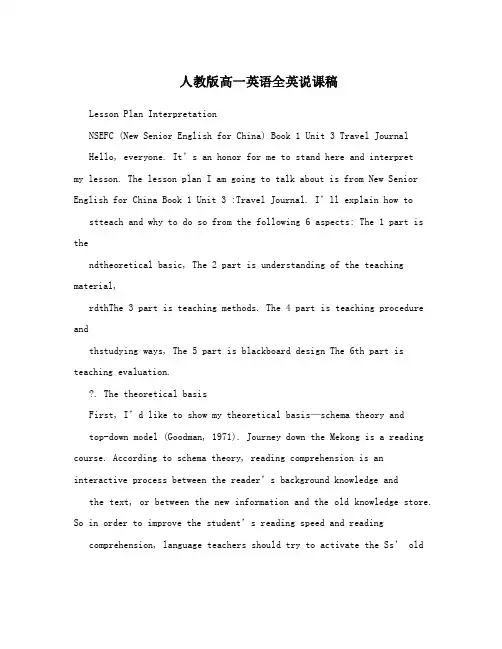
人教版高一英语全英说课稿Lesson Plan InterpretationNSEFC (New Senior English for China) Book 1 Unit 3 Travel Journal Hello, everyone. It’s an honor for me to stand here and interpretmy lesson. The lesson plan I am going to talk about is from New Senior English for China Book 1 Unit 3 :Travel Journal. I’ll explain how to stteach and why to do so from the following 6 aspects: The 1 part is thendtheoretical basic, The 2 part is understanding of the teaching material,rdthThe 3 part is teaching methods. The 4 part is teaching procedure andthstudying ways, The 5 part is blackboard design The 6th part is teaching evaluation.. The theoretical basisFirst, I’d like to show my theoretical basis—schema theory andtop-down model (Goodman, 1971). Journey down the Mekong is a reading course. According to schema theory, reading comprehension is an interactive process between the reader’s background knowledge and the text, or between the new information and the old knowledge store. So in order to improve the student’s r eading speed and reading comprehension, language teachers should try to activate the Ss’ oldknowledge store and add more relevant background knowledge before they get the students to read. According to the top-down model, general idea of the text will be got first, and then come to the details..Understanding of the teaching materialMy understanding of the teaching material includes 3 parts: thefirstpart: the second part: the status and the function, teaching objectives, the third part: the important and difficult point.At the beginning, let’s focus on the first part:Journey down the Mekong is a piece of travel journal written by Wang Kun. It’s mainly about Wang Kun and his sister’s dream of taking a greatbike trip down the Mekong River, their preparation for the trip and some more details of the Mekong River. General speaking, it is not difficult for the students to understand the text, but there are some new phrases and sentences that may be a little bit difficult. So before the students’f irst reading, I’ll explain the new words and phrases briefly and after reading the whole passage, I will embody the usage of the news words and phrases, and get the student understand the difficult sentences.a) That’s all for the first part, now let’s mo ve to the second part.According to the teaching material and the new curriculum of English, in order to fulfill the learning task of this lesson, I establish the following objective: Knowledge objectives, Ability objectives and Moral objectives.b) Knowledge objectivesBy the end of the lesson, Ss will have a better understanding of the meaning and structure of the text. Then Ss will grasp some useful words and expressions such as determined, make up one’s mind, give in, be fond of…, care about…, stub born, ect.c) Ability objectivesActually students should be encouraged to do speed reading in thefirst period of reading lesson. Since the main objective of reading course is to improve the Ss’ reading ability, I’ll train their ability ofinformation-gathering and summarizing. And the whole class is for Ss to develop their reading skills as scanning, skimming,information-gathering, and guessing the new words from the text. d) Moral objectivesThough Journey down the Mekong is mainly about the trip down the river, it also talks about the scenery and life along the river. So before learning the text, we will have a short discussion about the importance of the river. I want the Ss to have the awareness ofprotecting the river and protecting our environment.Well, so much for the reaching objectives, let’s come to deal with thethird part: the important points and the difficult points. According to the national curriculum of English and language learning theory, when teaching reading, I’ll encourage the Ss to do speed reading for thefirst time, that is to say, we should encourage our Ss to read as far as they can when whey do the first reading. The important points are that how to make Ss grasp the new words and phrases and how to improve their reading skills as scanning, skimming, information-gathering and summarizing. As to the difficult points, they are the same as the important ones.That’s all for my understanding of the teaching material. Nowlet’s focus on the ways of teaching and learning.. Teaching methods and studying waysGenerally speaking, I adopt task-based language teaching andcommunicative approach in my class. As for learning, Ss will learn through independent reading, discussing and cooperating.I will use computer and blackboard as my teaching aids..Teaching procedureHere comes the most important part, the teaching procedure. It includes 5 steps: Step1: Lead-in and pre-reading, Step2: While-reading, Step3: Consolidation, Step4: Post-reading, Step5: Homework.Step1: Lead-in and pre-reading (7mins)Now let’s come to the first step. There are three activities inthis step and will spend 7mins on them.In activity one, I will ask Ss two questions Here, as the Ss get familiar with the Chinese great rivers, I choose to ask them some great rivers in China.In activity two, I will ask the Ss discuss in pairs and answer the question “How do people who live along a river use it?” My purpose of this activity is to remind the Ss the importance of the river, thus stimulate the Ss’ aw areness of protecting the rivers.In the last activity, I will show the Sea picture of the MekongRiver and ask them to list the countries that it flows through. This activity leads in the while-reading.Step2: While-reading (21mins)While-reading is the main part and it will take 21mins. Here I adopt the top-down reading model. This step is divided into 2 parts: fast reading and careful reading. Before reading, I will ask the Ss predict what will talk in the text according to the title. It can exert the Ss’ imagination.1) Fast readingDuring fast reading, I will ask the Ss reading the whole passage quickly and get the main idea of each paragraph. The main idea of each paragraph will be matched because the Ss are lack of the skill of summarizing the main idea by themselves.2)Careful readingAfter getting the general idea of each paragraph, I will deal with the details Paragraph.In paragraph 1, I will ask the Ss to read quickly and do the exercises T or F. And if it is F, I will ask them to correct it. This exercise can help the Ss get the key understanding of the first paragraph.In paragraph 2, I will ask Ss one question “Is it a difficult journey tocycle along the Mekong? Why?” This can help the Ss develop their ability of summarizing.And in the last paragraph, I will ask the Ss two questions. In order to lower the difficult of the questions, I will show them the examples. After that, I will present some pictures to deepen the Ss’ impression on thenew words and help the Ss gain a deeper understanding on the Mekong River.Step 3: Consolidation (6mins)After dealing with the detailed information of each paragraph, Iwill ask the Ss to read the whole passage again and answer two questions to consolidate what they’ve learnt.Step 4: Post-reading (10mins)That is all for the while-reading. Now let’s move to the fourth step.In this step, I will design two activities and I will spend 10minson them.The first activity is filling in the blanks. In this activity, Ssare required to find the different attitudes of the trip. I can help the Ss train their ability of information-gathering and expression.The second activity is thinking. In this activity, I will ask the Ss to do discuss in groups of four. It can not only train their ability of analysis and comprehension, but also cultivate their spirit of cooperation. Step 5: HomeworkFinally it comes to the homework. Ss are required to review thelearnt lesson and underline the useful words and phrases in the text. This step is for them to consoli date what they’ve learnt and make preparationfor the next lesson---Learning about the Language.. Blackboard Design and Teaching evaluationOn the top, there is the title of this lesson. On the left, it lists some important roles that the river plays. On the right, there are some useful words and expressions.. Teaching evaluationWhile teaching, I will walk around the classroom and keep an eye on each student and praise their excellent performance. Self-examination will help me to improve the teaching quality and the relationship between the teacher and students.That’s all for my interpretation. Thank you.欢迎您阅读该资料,希望该资料能给您的学习和生活带来帮助,如果您还了解更多的相关知识,也欢迎您分享出来,让我们大家能共同进步、共同成长。
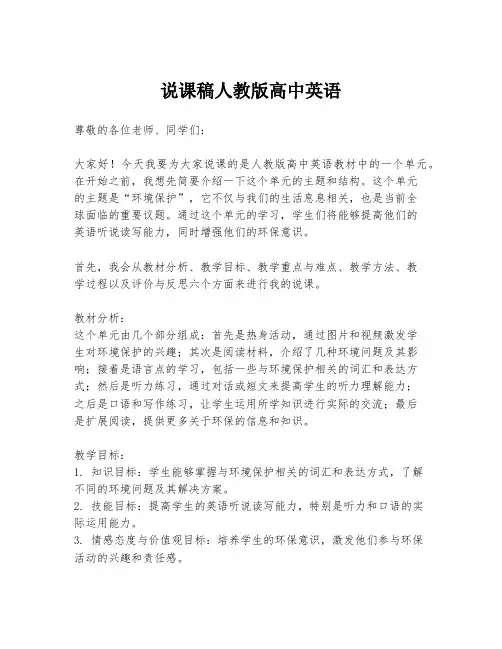
说课稿人教版高中英语尊敬的各位老师、同学们:大家好!今天我要为大家说课的是人教版高中英语教材中的一个单元。
在开始之前,我想先简要介绍一下这个单元的主题和结构。
这个单元的主题是“环境保护”,它不仅与我们的生活息息相关,也是当前全球面临的重要议题。
通过这个单元的学习,学生们将能够提高他们的英语听说读写能力,同时增强他们的环保意识。
首先,我会从教材分析、教学目标、教学重点与难点、教学方法、教学过程以及评价与反思六个方面来进行我的说课。
教材分析:这个单元由几个部分组成:首先是热身活动,通过图片和视频激发学生对环境保护的兴趣;其次是阅读材料,介绍了几种环境问题及其影响;接着是语言点的学习,包括一些与环境保护相关的词汇和表达方式;然后是听力练习,通过对话或短文来提高学生的听力理解能力;之后是口语和写作练习,让学生运用所学知识进行实际的交流;最后是扩展阅读,提供更多关于环保的信息和知识。
教学目标:1. 知识目标:学生能够掌握与环境保护相关的词汇和表达方式,了解不同的环境问题及其解决方案。
2. 技能目标:提高学生的英语听说读写能力,特别是听力和口语的实际运用能力。
3. 情感态度与价值观目标:培养学生的环保意识,激发他们参与环保活动的兴趣和责任感。
教学重点与难点:重点:掌握环保相关词汇和表达,提高听说能力。
难点:如何将所学知识与实际生活相结合,提高学生的口语表达能力和写作能力。
教学方法:1. 任务型教学法:通过设计各种任务,让学生在完成任务的过程中学习和使用英语。
2. 合作学习:鼓励学生进行小组合作,通过讨论和交流提高他们的交际能力。
3. 多媒体教学:利用图片、视频等多媒体材料,激发学生的学习兴趣和参与度。
教学过程:1. 导入(5分钟):通过展示一些关于环境问题的图片和视频,引起学生的注意和兴趣。
2. 阅读(15分钟):学生阅读课文,了解不同的环境问题,并标记不熟悉的词汇和表达。
3. 词汇与表达学习(10分钟):教师解释和练习课文中的重点词汇和表达方式。
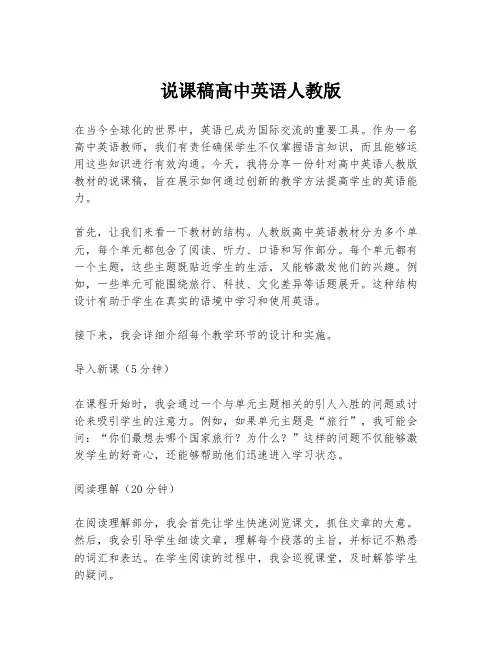
说课稿高中英语人教版在当今全球化的世界中,英语已成为国际交流的重要工具。
作为一名高中英语教师,我们有责任确保学生不仅掌握语言知识,而且能够运用这些知识进行有效沟通。
今天,我将分享一份针对高中英语人教版教材的说课稿,旨在展示如何通过创新的教学方法提高学生的英语能力。
首先,让我们来看一下教材的结构。
人教版高中英语教材分为多个单元,每个单元都包含了阅读、听力、口语和写作部分。
每个单元都有一个主题,这些主题既贴近学生的生活,又能够激发他们的兴趣。
例如,一些单元可能围绕旅行、科技、文化差异等话题展开。
这种结构设计有助于学生在真实的语境中学习和使用英语。
接下来,我会详细介绍每个教学环节的设计和实施。
导入新课(5分钟)在课程开始时,我会通过一个与单元主题相关的引人入胜的问题或讨论来吸引学生的注意力。
例如,如果单元主题是“旅行”,我可能会问:“你们最想去哪个国家旅行?为什么?”这样的问题不仅能够激发学生的好奇心,还能够帮助他们迅速进入学习状态。
阅读理解(20分钟)在阅读理解部分,我会首先让学生快速浏览课文,抓住文章的大意。
然后,我会引导学生细读文章,理解每个段落的主旨,并标记不熟悉的词汇和表达。
在学生阅读的过程中,我会巡视课堂,及时解答学生的疑问。
接着,我会组织学生进行小组讨论,让他们分享各自的理解,并讨论文章中的关键信息。
通过这种方式,学生可以在交流中加深对文章的理解,并学习如何用英语表达自己的观点。
词汇与语法(15分钟)在词汇与语法环节,我会重点讲解学生在阅读中遇到的难点词汇和语法结构。
我会通过例句和图片来帮助学生理解和记忆新词汇,并设计一些填空或改错练习来巩固他们的语法知识。
此外,我还会鼓励学生尝试用新学的词汇和语法结构来造句,这样可以提高他们运用语言的能力。
通过实际应用,学生能够更好地掌握英语的使用。
听力训练(15分钟)听力是英语学习中非常重要的一部分。
我会利用教材附带的听力材料进行训练。
首先,我会让学生听录音并回答问题,以检测他们的听力理解能力。
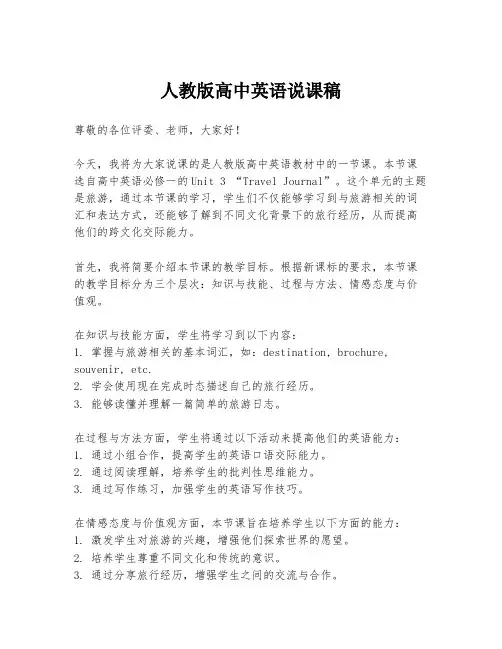
人教版高中英语说课稿尊敬的各位评委、老师,大家好!今天,我将为大家说课的是人教版高中英语教材中的一节课。
本节课选自高中英语必修一的Unit 3 “Travel Journal”。
这个单元的主题是旅游,通过本节课的学习,学生们不仅能够学习到与旅游相关的词汇和表达方式,还能够了解到不同文化背景下的旅行经历,从而提高他们的跨文化交际能力。
首先,我将简要介绍本节课的教学目标。
根据新课标的要求,本节课的教学目标分为三个层次:知识与技能、过程与方法、情感态度与价值观。
在知识与技能方面,学生将学习到以下内容:1. 掌握与旅游相关的基本词汇,如:destination, brochure, souvenir, etc.2. 学会使用现在完成时态描述自己的旅行经历。
3. 能够读懂并理解一篇简单的旅游日志。
在过程与方法方面,学生将通过以下活动来提高他们的英语能力:1. 通过小组合作,提高学生的英语口语交际能力。
2. 通过阅读理解,培养学生的批判性思维能力。
3. 通过写作练习,加强学生的英语写作技巧。
在情感态度与价值观方面,本节课旨在培养学生以下方面的能力:1. 激发学生对旅游的兴趣,增强他们探索世界的愿望。
2. 培养学生尊重不同文化和传统的意识。
3. 通过分享旅行经历,增强学生之间的交流与合作。
接下来,我将详细介绍本节课的教学内容和教学步骤。
教学内容主要包括三个部分:词汇学习、阅读理解和写作练习。
1. 词汇学习:我将通过图片、实物和情景模拟的方式,引入与旅游相关的词汇。
例如,我会展示不同旅游目的地的图片,并让学生尝试用英语描述这些地方。
同时,我会引导学生通过小组讨论,分享他们自己的旅行经历,并尝试使用新学的词汇。
2. 阅读理解:我会选取一篇适合学生阅读水平的旅游日志,让学生在阅读中学习如何使用现在完成时态描述旅行经历。
在阅读过程中,我会设置一些问题,引导学生深入理解文章内容,并鼓励他们提出自己的见解。
3. 写作练习:在本节课的最后部分,我将让学生尝试写一篇简短的旅游日志,描述他们自己的一次旅行经历。
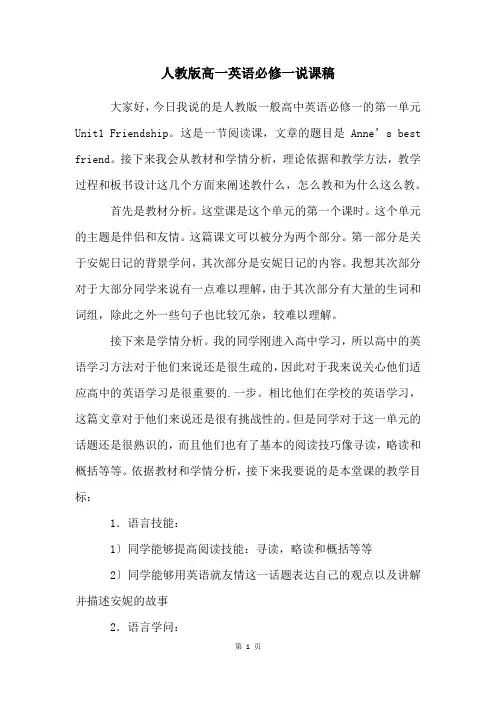
人教版高一英语必修一说课稿大家好,今日我说的是人教版一般高中英语必修一的第一单元Unit1 Friendship。
这是一节阅读课,文章的题目是Anne’s best friend。
接下来我会从教材和学情分析,理论依据和教学方法,教学过程和板书设计这几个方面来阐述教什么,怎么教和为什么这么教。
首先是教材分析。
这堂课是这个单元的第一个课时。
这个单元的主题是伴侣和友情。
这篇课文可以被分为两个部分。
第一部分是关于安妮日记的背景学问,其次部分是安妮日记的内容。
我想其次部分对于大部分同学来说有一点难以理解,由于其次部分有大量的生词和词组,除此之外一些句子也比较冗杂,较难以理解。
接下来是学情分析。
我的同学刚进入高中学习,所以高中的英语学习方法对于他们来说还是很生疏的,因此对于我来说关心他们适应高中的英语学习是很重要的.一步。
相比他们在学校的英语学习,这篇文章对于他们来说还是很有挑战性的。
但是同学对于这一单元的话题还是很熟识的,而且他们也有了基本的阅读技巧像寻读,略读和概括等等。
依据教材和学情分析,接下来我要说的是本堂课的教学目标:1.语言技能:1〕同学能够提高阅读技能:寻读,略读和概括等等2〕同学能够用英语就友情这一话题表达自己的观点以及讲解并描述安妮的故事2.语言学问:1〕同学能够把握一些生词和词组像是German, on purpose,in order to, at dusk, power等等3.情感看法:1〕同学知道生活的美妙之处,对生活保持乐观的看法4.文化意识:1〕同学能够知道一些二战的学问特殊是犹太人的历史5.学习策略:1〕同学通过上网搜集安妮的资料来提高资源策略2〕同学通过小组商量等来提高交际策略重点:1)同学能够提高他们的阅读技巧像是略读,寻读,概括等等2)同学能够用英语就友情这一话题表达自己的观点以及讲解并描述安妮的故事难点:1)同学能够用英语就友情这一话题表达自己的观点以及讲解并描述安妮的故事下面我要说的是理论依据和教学方法.依据英语新课程标准,英语课堂应当以同学为中心,同学在课堂中起主导作用,所以在我的课上我会给同学足够的时间去表达他们的观点和操练英语.除此之外,我还会先激活同学的旧学问来关心他们学习新学问。
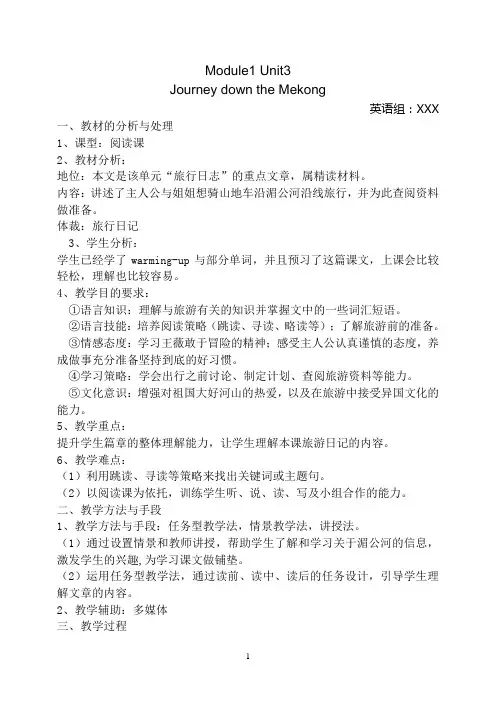
Module1 Unit3Journey down the Mekong英语组:XXX一、教材的分析与处理1、课型:阅读课2、教材分析:地位:本文是该单元“旅行日志”的重点文章,属精读材料。
内容:讲述了主人公与姐姐想骑山地车沿湄公河沿线旅行,并为此查阅资料做准备。
体裁:旅行日记3、学生分析:学生已经学了warming-up与部分单词,并且预习了这篇课文,上课会比较轻松,理解也比较容易。
4、教学目的要求:①语言知识:理解与旅游有关的知识并掌握文中的一些词汇短语。
②语言技能:培养阅读策略(跳读、寻读、略读等);了解旅游前的准备。
③情感态度:学习王薇敢于冒险的精神;感受主人公认真谨慎的态度,养成做事充分准备坚持到底的好习惯。
④学习策略:学会出行之前讨论、制定计划、查阅旅游资料等能力。
⑤文化意识:增强对祖国大好河山的热爱,以及在旅游中接受异国文化的能力。
5、教学重点:提升学生篇章的整体理解能力,让学生理解本课旅游日记的内容。
6、教学难点:(1)利用跳读、寻读等策略来找出关键词或主题句。
(2)以阅读课为依托,训练学生听、说、读、写及小组合作的能力。
二、教学方法与手段1、教学方法与手段:任务型教学法,情景教学法,讲授法。
(1)通过设置情景和教师讲授,帮助学生了解和学习关于湄公河的信息,激发学生的兴趣,为学习课文做铺垫。
(2)运用任务型教学法,通过读前、读中、读后的任务设计,引导学生理解文章的内容。
2、教学辅助:多媒体三、教学过程Step1: Lead inAsk some students to present their dialogue.(The homework of last class)【设计说明】采用对话形式导入,营造出宽松的学习气氛,为学生全面的课堂参与作了铺垫。
Step2: Pre-readingShow students some pictures and maps to know more about the Mekong river, its two names and the route it flows out of China.1. Names: Lancang River and Mekong River2. Route: China-Myanmar-Laos-Thailand-Cambodia-Vietnam-South China sea 【设计说明】利用图片来了解湄公河,为课文第三段做铺垫,同时,激发了学生的兴趣和好奇心。
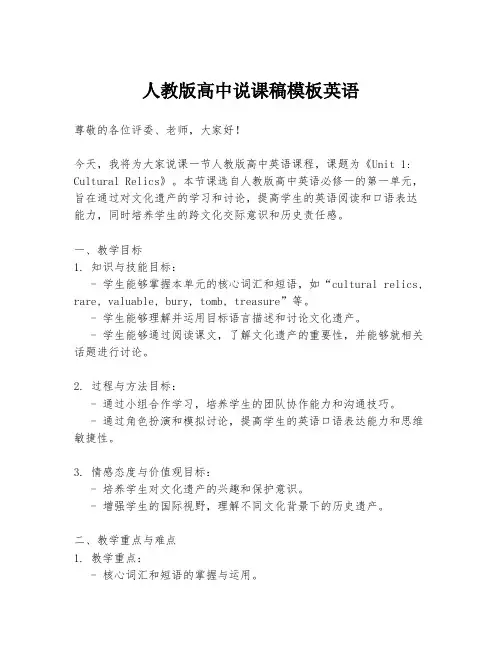
人教版高中说课稿模板英语尊敬的各位评委、老师,大家好!今天,我将为大家说课一节人教版高中英语课程,课题为《Unit 1: Cultural Relics》。
本节课选自人教版高中英语必修一的第一单元,旨在通过对文化遗产的学习和讨论,提高学生的英语阅读和口语表达能力,同时培养学生的跨文化交际意识和历史责任感。
一、教学目标1. 知识与技能目标:- 学生能够掌握本单元的核心词汇和短语,如“cultural relics, rare, valuable, bury, tomb, treasure”等。
- 学生能够理解并运用目标语言描述和讨论文化遗产。
- 学生能够通过阅读课文,了解文化遗产的重要性,并能够就相关话题进行讨论。
2. 过程与方法目标:- 通过小组合作学习,培养学生的团队协作能力和沟通技巧。
- 通过角色扮演和模拟讨论,提高学生的英语口语表达能力和思维敏捷性。
3. 情感态度与价值观目标:- 培养学生对文化遗产的兴趣和保护意识。
- 增强学生的国际视野,理解不同文化背景下的历史遗产。
二、教学重点与难点1. 教学重点:- 核心词汇和短语的掌握与运用。
- 课文内容的理解和讨论,尤其是对文化遗产价值的认识。
2. 教学难点:- 学生如何准确、流畅地表达对文化遗产的看法和情感。
- 如何引导学生深入思考文化遗产的保护与传承问题。
三、教学准备1. 教师准备:- 准备多媒体课件,包括文化遗产的图片和视频资料。
- 准备相关的词汇卡片和练习题。
2. 学生准备:- 提前预习课文,熟悉词汇和句型。
- 收集有关文化遗产的资料,准备分享。
四、教学过程1. 导入新课:- 通过展示文化遗产的图片,激发学生的兴趣和好奇心。
- 通过提问引出话题,如“你知道哪些世界著名的文化遗产?”2. 课文学习:- 学生自主阅读课文,标记不熟悉的词汇和句子。
- 教师讲解重点词汇和短语,学生跟读并记忆。
- 学生分组讨论课文内容,分享对文化遗产的看法。
3. 语言实践:- 分组进行角色扮演,模拟文化遗产保护的讨论会。
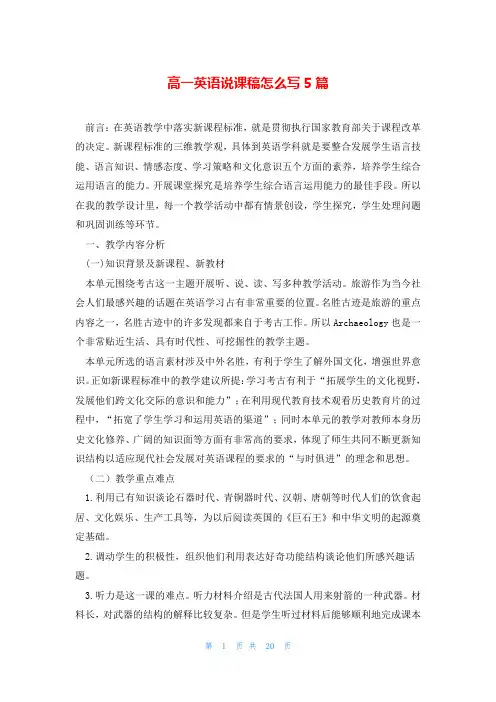
高一英语说课稿怎么写5篇前言:在英语教学中落实新课程标准,就是贯彻执行国家教育部关于课程改革的决定。
新课程标准的三维教学观,具体到英语学科就是要整合发展学生语言技能、语言知识、情感态度、学习策略和文化意识五个方面的素养,培养学生综合运用语言的能力。
开展课堂探究是培养学生综合语言运用能力的最佳手段。
所以在我的教学设计里,每一个教学活动中都有情景创设,学生探究,学生处理问题和巩固训练等环节。
一、教学内容分析(一)知识背景及新课程、新教材本单元围绕考古这一主题开展听、说、读、写多种教学活动。
旅游作为当今社会人们最感兴趣的话题在英语学习占有非常重要的位置。
名胜古迹是旅游的重点内容之一,名胜古迹中的许多发现都来自于考古工作。
所以Archaeology也是一个非常贴近生活、具有时代性、可挖掘性的教学主题。
本单元所选的语言素材涉及中外名胜,有利于学生了解外国文化,增强世界意识。
正如新课程标准中的教学建议所提:学习考古有利于“拓展学生的文化视野,发展他们跨文化交际的意识和能力”;在利用现代教育技术观看历史教育片的过程中,“拓宽了学生学习和运用英语的渠道”;同时本单元的教学对教师本身历史文化修养、广阔的知识面等方面有非常高的要求,体现了师生共同不断更新知识结构以适应现代社会发展对英语课程的要求的“与时俱进”的理念和思想。
(二)教学重点难点1.利用已有知识谈论石器时代、青铜器时代、汉朝、唐朝等时代人们的饮食起居、文化娱乐、生产工具等,为以后阅读英国的《巨石王》和中华文明的起源奠定基础。
2.调动学生的积极性,组织他们利用表达好奇功能结构谈论他们所感兴趣话题。
3.听力是这一课的难点。
听力材料介绍是古代法国人用来射箭的一种武器。
材料长,对武器的结构的解释比较复杂。
但是学生听过材料后能够顺利地完成课本上的练习。
这里不要求学生理解细节,只要能完成练习就行。
二、三维教学目标(一)知识技能1.学会谈论古代人的生产、生活;2.学会表达对什么东西的好奇,如:I wonder what who… I really want to know…I’m curious to…I’d love to know…I wonder ifwhether… Wha t I’d really like to fin d out is… I’m curious about… I’d like to know more about…3.学习一些与考古有关单词、短语和句式,如:archaeology及其派生词,curiosity, bronze, dynasty,decoration, artifact, unearth, spear, pot等。

说课稿人教版高一英语traveljournal教案——Unit 3 Travel JournalTeaching material:This unit is to introduce the travelling to us. The reading passage is the center of this unit. It is the most important teaching material in this lesson, which contains most of the vocabularies and grammar points that students should learn.Teaching objectives:Language objectives:(1) To help students understand and master the new words, phrases and sentence patterns;(2) To have deeper understand the topic of travelling.Ability objectives:(1) To grasp some reading ability such as guessing, skimming, scanning and so on;(2) T o cultivate students’ spirit of cooperation with classmates.Emotional objectives:To make students love our country and nature;Analysis of the students:Although the students have the basic abilities of learning, speaking, reading and writing, they still need many opportunities to practice what they have learned and to develop their autonomous learning ability and cooperative learning ability. Teaching important and difficult points:Based on the requirement of the syllabus, the important point is to help students understand the whole passage and be able talk about the travel in English.The difficult point is to master the useful words andexpressions and improve students’ ability to read an article.Teaching methods and studying ways:Generally speaking, I adopt task-based language teaching and communicative approach in my class. As for learning, students will master the knowledge through independent reading, discussing and cooperating.Teaching aids:Multi-media computer: OHP(overhead projector), tape recorder, software, PowerPoint or authorwareTeaching procedures:Step 1: lead in and pre-readingIt will spend 7mins. At the beginning of the class, I will lead in the reading material by the following two activities: First I will ask the students to discuss in pairs and answer the question "How dopeople who live beside a river make use of it in their daily life?” My purpose of this activity is to remind the students the importance of the river, thus stimulate the students' awareness of protecting the rivers.The second activity is that I will show the students a picture of the Mekong River and ask them to look at the map on page 18 and to list the countries that it flows through. This activity leads in the while-reading.Step 2: While-readingWhile-reading is the main part and it will take 21mins. Here I adopt the top-down reading model. This step is divided into 2 parts: fast reading and careful reading. Before reading, I will ask the students to predict what will talk in the text according to the title. It can exert the students ' imagination.1. Fast reading (6mins)During fast reading, I will ask the students to reading the whole passage quickly and get the main idea of each paragraph. Usually, the main idea of each paragraph is the first sentence or the last sentence, but this text is not. So the main idea of each paragraph will be matched because the students are lack of the skill of summarizing the main idea by them.2. Intensive reading (10mins)While reading, I will make students try to find the detail information about the story by discussing and answering the following questions:In paragraph two, I will ask students a question “Is it a difficult journey to cycle along the Mekong? Why?” This can help the students develop their ability of summarizing.In the last paragraph, I will ask students two questions “How does the water of Meko ng River change?” and “What can you see when you travel along the Mekong River?” Both quest ions are required to answer in keys word. After answering these questions, students can gain a deeper understanding on the Mekong River.At the same time, let the students learn the new words, such as ever since, persuade, graduate from, schedule, be fond of, shortcoming, care about and so on. Step 3: Post-reading In this step, I will design two activities and I will spend 10 minutes on them.The first activity is filling in the blanks. In this activity, students are required to find the different attitudes of Wang Kun and Wang Wei to the trip, and then the teacher will express her attitude to this trip. After demonstrating, students are encouraged to express their attitudes. It can help the students train their ability of information-gathering and expression.The second activity is thinking. In this activity, I will ask the students to discuss in groups of four and try to use some words to describe the characteristics of Wang Kun and Wang Wei according to their attitudes. It is really difficult, but it can not only train their ability of analysis and comprehension, but also cultivate their spirit of cooperation.Step 4: Consolidation (6mins)After dealing with the detailed information of each paragraph, I will ask the students to read the whole passage again and answer some questions to consolidate what they’ve learnt. It will take 6 minutes. For example, “Where is the source of the Mekong River and which sea does it en ter?”Step 5:Homework (1min)Students are required to review the learnt lesson and underline the useful words and phrases in the text. This one is for them to consolidate what they’ve learnt and make preparation for the next lesson.Blackboard designOn the top, there is the title of this lesson. On the left, it lists some important roles that the river plays. On the right, there are some useful words and expressions. T eaching affectThis lesson is well organized and in good order. Students’ interest is aroused and they are active in class. The most important is that every student can learn something important from this lesson.。
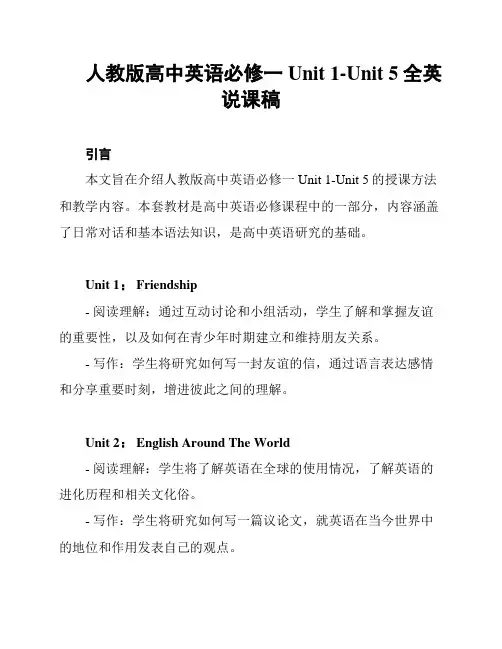
人教版高中英语必修一Unit 1-Unit 5全英说课稿引言本文旨在介绍人教版高中英语必修一Unit 1-Unit 5的授课方法和教学内容。
本套教材是高中英语必修课程中的一部分,内容涵盖了日常对话和基本语法知识,是高中英语研究的基础。
Unit 1: Friendship- 阅读理解:通过互动讨论和小组活动,学生了解和掌握友谊的重要性,以及如何在青少年时期建立和维持朋友关系。
- 写作:学生将研究如何写一封友谊的信,通过语言表达感情和分享重要时刻,增进彼此之间的理解。
Unit 2: English Around The World- 阅读理解:学生将了解英语在全球的使用情况,了解英语的进化历程和相关文化俗。
- 写作:学生将研究如何写一篇议论文,就英语在当今世界中的地位和作用发表自己的观点。
Unit 3: Travel journal- 阅读理解:通过阅读游记和旅行日记,学生将扩大英语词汇量和了解不同的文化和历史。
- 写作:学生将研究如何写一篇旅行日记,描述自己的旅行经历和感悟,提高英语写作的能力。
Unit 4: Amazing Science- 阅读理解:学生将了解科学发展的历史,以及人类对自然的探索和解释;学会如何从科学文章中获取信息。
- 写作:学生将研究如何写一篇科普短文,介绍感兴趣的科学领域的最新进展。
Unit 5: Music- 阅读理解:学生将了解音乐的历史和文化,掌握音乐相关的词汇和概念。
- 写作:学生将研究如何写一篇关于音乐的文章,和同学分享自己对音乐的喜好和见解。
结论本文介绍了人教版高中英语必修一Unit 1-Unit 5的授课方法和教学内容,通过丰富的教学活动和提高英语写作能力,全面提升学生的英语水平和综合素质。
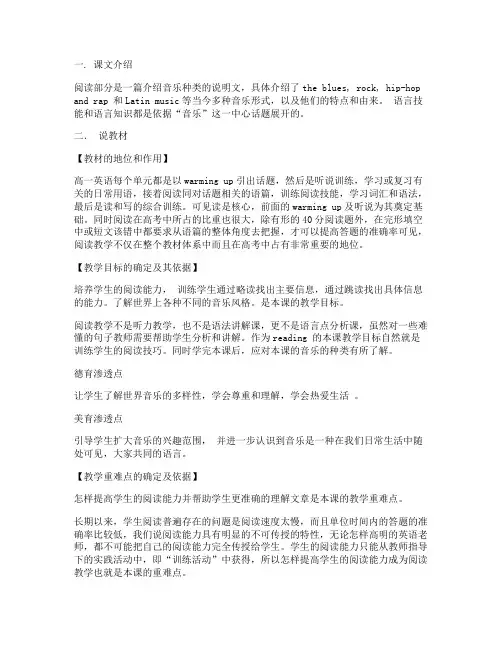
一. 课文介绍阅读部分是一篇介绍音乐种类的说明文,具体介绍了the blues, rock, hip-hop and rap 和Latin music等当今多种音乐形式,以及他们的特点和由来。
语言技能和语言知识都是依据“音乐”这一中心话题展开的。
二.说教材【教材的地位和作用】高一英语每个单元都是以warming up引出话题,然后是听说训练,学习或复习有关的日常用语,接着阅读同对话题相关的语篇,训练阅读技能,学习词汇和语法,最后是读和写的综合训练。
可见读是核心,前面的warming up及听说为其奠定基础。
同时阅读在高考中所占的比重也很大,除有形的40分阅读题外,在完形填空中或短文该错中都要求从语篇的整体角度去把握,才可以提高答题的准确率可见,阅读教学不仅在整个教材体系中而且在高考中占有非常重要的地位。
【教学目标的确定及其依据】培养学生的阅读能力,训练学生通过略读找出主要信息,通过跳读找出具体信息的能力。
了解世界上各种不同的音乐风格。
是本课的教学目标。
阅读教学不是听力教学,也不是语法讲解课,更不是语言点分析课,虽然对一些难懂的句子教师需要帮助学生分析和讲解。
作为reading 的本课教学目标自然就是训练学生的阅读技巧。
同时学完本课后,应对本课的音乐的种类有所了解。
德育渗透点让学生了解世界音乐的多样性,学会尊重和理解,学会热爱生活。
美育渗透点引导学生扩大音乐的兴趣范围,并进一步认识到音乐是一种在我们日常生活中随处可见,大家共同的语言。
【教学重难点的确定及依据】怎样提高学生的阅读能力并帮助学生更准确的理解文章是本课的教学重难点。
长期以来,学生阅读普遍存在的问题是阅读速度太慢,而且单位时间内的答题的准确率比较低,我们说阅读能力具有明显的不可传授的特性,无论怎样高明的英语老师,都不可能把自己的阅读能力完全传授给学生。
学生的阅读能力只能从教师指导下的实践活动中,即“训练活动”中获得,所以怎样提高学生的阅读能力成为阅读教学也就是本课的重难点。
人教版新课标版高一英语必修1Unit5说课稿高中英语新教必修一Unit5说课稿Period 5Language study这部分的重点是学习掌握关系副词when,where,why引导的定语从句及介词+关系代词引导的定语从句。
Task: To talk about some famous directors in China and some of their most famous and popular films, using attributive clause.Step1.Pre-taskActivity1.Revision班级活动:Have are vision about Steven Spielberg.What did he do?How was he successful?What great films did he direct?Activity2. Talk about some famous Chine directors and their films.doggystyle师生互动:教师提一些问题如What Chine directors do you know? What are their well-known films?在此过程中教师可展示一些学生熟vest是什么意思悉的国内知名导演的海the vow报,从视觉上激发学生的兴趣。
然后谈论某个导演及他的代表作品,引出定语从如Zhang Yimou is the famous director who successfully directed the film Hero.(Show a table of the four famous directors with their photos and their films in the CAI. Ask students to discuss and put in right orders) Directors(Photos)FilmsFeng Xiaoning(冯小宁)I’ll Be Here for You(不见不散)Pekinger in New York(北京人在纽约)Chen Kaige(陈凯歌)Purple Sun t(紫日)Red River Valley(红河谷)Zhang Yimou(张艺谋)Not One Less你见或者不见我>英语阅读理解100篇(一个也不能少)Hero(英雄)Feng Xiaogang(冯小刚)danceTogether(和你在一起)Farewell, My Concubine(霸王别姬)Activity3. Talk about actors and actress小组活动:教师选取几副大家熟悉的国产大片的电影画面,要求学生进行小组讨论,分别来自什么电影,他们的男、女主角(mainactor/actress)分别是谁。
高中人教版英语说课稿模板尊敬的各位老师,大家好。
今天,我将为大家展示一节高中英语课程的说课稿。
本节课选自人教版高中英语教材,旨在通过本节课的学习,帮助学生掌握相关的英语知识,提高他们的语言运用能力。
一、教学目标本节课的教学目标是:1. 知识目标:使学生能够理解并掌握本课的新词汇和短语,能够正确使用这些词汇和短语进行表达。
2. 技能目标:通过听力、口语、阅读和写作练习,提高学生的英语听说读写能力。
3. 情感目标:激发学生学习英语的兴趣,培养他们用英语进行交流的自信心。
二、教学重点本节课的教学重点是:1. 词汇与短语的掌握。
2. 语法结构的运用。
3. 语言的实际运用能力。
三、教学难点本节课的教学难点是:1. 学生对新词汇的理解和记忆。
2. 语法结构的准确运用。
3. 学生在实际语境中灵活运用英语的能力。
四、教学方法为了达到教学目标,我将采用以下教学方法:1. 直观教学法:通过图片、实物等直观手段帮助学生理解新词汇。
2. 互动教学法:通过小组讨论、角色扮演等活动,提高学生的参与度和实践能力。
3. 任务型教学法:设计具体的语言任务,使学生在完成任务的过程中学习和使用英语。
五、教学过程1. 导入(Lead-in):通过提问或展示图片,激发学生对本课主题的兴趣。
2. 新课呈现(Presentation):介绍新词汇和语法结构,通过例句和解释帮助学生理解。
3. 练习(Practice):设计多种形式的练习,如填空、翻译、造句等,巩固学生对新知识的掌握。
4. 应用(Application):通过角色扮演、小组讨论等活动,让学生在实际语境中运用所学知识。
5. 总结(Summary):回顾本课的重点和难点,确保学生对所学内容有清晰的理解。
6. 作业(Homework):布置适量的作业,包括词汇记忆、语法练习和阅读材料,以巩固课堂学习。
六、板书设计板书设计简洁明了,包括:- 新词汇和短语- 语法结构- 重要例句七、教学反思在课后,我会反思本节课的教学效果,收集学生的反馈,以便不断改进教学方法和内容。
高中英语人教版英语说课稿尊敬的各位评委、老师,大家好!今天,我将为大家说课高中英语人教版必修一的Unit 3《Travel Journal》。
本单元的主题是旅行,通过学习本单元,学生不仅能够学习到与旅行相关的词汇和表达方式,还能够了解到不同文化背景下的旅行经历和感受,从而拓宽他们的国际视野。
一、教学目标1. 知识目标:学生能够掌握与旅行相关的基本词汇和表达,如“destination, guidebook, brochure, souvenir”等,并能够运用这些词汇进行基本的交流。
2. 能力目标:通过阅读和听力练习,提高学生的理解和获取信息的能力。
同时,通过口语和写作练习,加强学生的表达和组织语言的能力。
3. 情感态度与价值观目标:通过本单元的学习,激发学生对旅行的兴趣,培养他们的跨文化交流意识和尊重不同文化的价值观。
二、教学重点与难点1. 教学重点:掌握旅行相关的词汇和表达,理解并运用在听说读写各方面。
2. 教学难点:如何引导学生通过旅行这一主题,深入理解和表达个人的感受和经历,以及如何进行跨文化的交流和理解。
三、教学过程1. 导入(Lead-in)首先,我会通过展示一些世界各地的风景图片来吸引学生的注意力,并引导他们谈论自己去过的地方或者想去的地方。
通过这种方式,学生能够迅速进入学习状态,并对旅行这一主题产生兴趣。
2. 预习(Pre-reading)接下来,我会让学生预习课文中的生词和短语,以便他们在阅读过程中能够更好地理解内容。
同时,我会教授一些阅读技巧,如略读(skimming)和扫读(scanning),帮助学生提高阅读效率。
3. 阅读(Reading)在阅读环节,学生将会阅读一篇关于旅行的短文。
我会引导学生运用预习时学到的阅读技巧,理解文章的主旨大意,并提取关键信息。
在阅读后,我会组织学生进行小组讨论,分享他们在文章中读到的有趣信息或者他们的旅行经历。
4. 听力(Listening)听力部分,我会播放一段与旅行相关的对话或短文,让学生在听的过程中完成一些听力练习,如填写信息表格或者回答问题。
高中英语新教必修<一>说课稿d 5这部分的重点是学习掌握关系副词w hen,,why引导的定语从句及介词+关系代词引导的定语从句。
e..Pre-taski on班级活动b erg.What did he do??t?.师生互动:教师提一些问题如-?在此过程中教师可展示一些学生熟悉的国内知名导演的海报,从视觉上激发学生的兴趣。
然后谈论某个导演及他的代表作品,引出定语从句。
如t ed the film Hero.ss)s)i ng(冯小宁)’ B 不见不散)g er in New York(北京人在纽约)(陈凯歌)e Sun set(紫日)y(红河谷)(张艺谋)Not One Less(一个也不能少)Hero(英雄)a ng(冯小刚)h er(和你在一起)b ine(霸王别姬)s s小组活动:教师选取几副大家熟悉的国产大片的电影画面,要求学生进行小组讨论,分别来自什么电影,他们的男、女主角(s s)分别是谁。
然后用定语从句知识来谈论。
如:the main role.s sr(少林足球)Rush Hour(尖峰时刻)Hero(英雄)i(旋风小子)h ing T n(卧虎藏龙)如:the film Hero_____.-r es班级活动:给出几副图片及几个关键词(r ds),用所学定语从句来描述图片。
如:1)北京申奥成功图B j ing the city 2008B will be held.2)香港回归图1997 the year Hong Kong3)新中国成立图n大组活动:全班以座位为单位分大组,开展竞赛。
1)小组讨论,两人一组,一学生创设一个情景并给出2--3个关键词,另一名同学用定语从句等)进行描述。
2)班级活动;结果汇报,教师记录,看哪个大组能正确描述的情景最多。
教师给出评价。
例如:n tA: 1988 the yearn tB:1988 is the year when I was bornn tA a ursB…s个人活动:i ses on P33..Post-tasko rkw)2.用定语从句修改影片英语简介。
高一英语说课稿优秀范文五篇作为老师,要懂得如何设计说课稿,下面就是我给大家带来的高一英语说课稿优秀范文五篇,盼望大家喜爱!高一英语说课稿1一、说教材(一)教材内容及分析我说课的内容是外研版《英语》(新标准)高中第一册(必修1)Module 2 My New Teachers 的Reading and V ocabulary的短文阅读。
本模块以My New Teachers 为话题,介绍了具有不同教学风格和共性特征的老师,旨在通过模块的教学使同学学会描述老师及校内生活,并能运用所学词汇、句型来表达自己的喜好,同时通过学习制定好老师的标准使师生之间相互了解。
Introduction 部分已主要介绍表示共性特征的形容词,并通过听力活动对描述老师风格的陈述进行推断;Reading and V ocabulary部分要求同学利用供应的词汇阅读三篇短文,了解不同老师的教学风格。
训练同学围绕学校生活对老师共性特征、教学风格进行由浅入深的描写。
(二)教学目标依据《新课标》总目标的描述,结合本课的内容,我把本节课的教学目标系统化,分别是:语言学问,力量目标,情感目标,文化意识,和学习策略。
1.语言学问目标把握并能运用下列词汇:tient,serious,intelligent,energetic,amusing,nervous,shy,strict,impression,re spect,organise,appreciate,admit…2.语言技能目标运用表示共性特征的词汇描述熟识的人物;理解介绍老师风格的短文,了解不同老师的共性特征和教学风格,猎取信息并把握和理解的观点;简洁描写自己身边的老师。
3.学习策略目标搜集和运用所学词汇、短语;对介绍教学风格的材料进行理解、分析、比较和总结;体现自主合作探究相结合。
4.文化意识和情感态度目标加深对老师的了解和喜爱, 既发挥学习主动性也协作老师的教学工作,实现感情沟通, 使师生关系更加融洽。
高一英语说课稿高一英语说课稿作为一名默默奉献的教育工作者,可能需要进行说课稿编写工作,通过说课稿可以很好地改正讲课缺点。
那么说课稿应该怎么写才合适呢?以下是小编为大家整理的高一英语说课稿,仅供参考,希望能够帮助到大家。
高一英语说课稿1一、本课在新教材中的地位我说课的课题是高中英语第一册(上),第8单元。
本单元的中心话题是运动,随着经济发展、社会进步、人们生活水平的提高,截止来越多的人开始关注健康问题,而体育运动无疑是人们津津乐道的了,而且正值2012年奥运会结束,我国体育代表团取得辉煌成绩。
下届奥运会将在北京举办,学生们会对此话题非常感兴趣。
所有的语言知识和语言技能几乎都是围绕这一中心话题而设计的。
本课是本单元的第一课时,是一节听说课,听说课是每单元教学的重要环节,为后面的阅读部分贮备知识。
本课包括奥运知道问答,体育项目比赛的听力材料以及关于爱好的对话练习。
二、教学目标与要求根据大纲“巩固,扩大学生的基础知识”和关于词汇方面的要求,以及英语学科的语言特点,我确定本课的教学知识目标为两点:一是要求学生掌握大纲规定的所有四会三会的单词。
二是要求学生对听力材料进行较好的理解,即了解有关体育赛事的英语解说,及最终能写出体育报道。
根据大纲“培养学生听说读写的能力”的要求,我确立的第一能力目标为扩大高一学生词汇量,以为阅读能力的提高打基础。
第二个能力目标为发展学生的记忆、想象、比较、分析和快速反应等能力。
确立此目标的依据是英语教学大纲的“发展智力、提高思维、观察、注意、记忆、想象、联想等能力”的要求。
三、教学重点及难点本节课为听说课,在于培养和提高学生的听说能力,所以单词词组及第二部分听力将本单元的教学重点,而其中听力部分的选材比较地道,学生基本第一次接触此类听力文章,所以在教学中这将成为教学难点。
四、教学方法1、情景教学法,其中包括对话、讨论、展示等。
2、开放式教学,如:brainstorming, role play, given situations 等活动3、任务型教学策略,在交际中进行真实运用。
人教版高一年级英语说课稿 人教版高一年级英语说课稿(一) 一、本课在教材中的地位 我说课的课题是高中英语第一册(上),第11单元,第42课,美国乡村音乐。本课是本单元的第二课时,是一节阅读课,阅读课是每单元教学的重要环节。本课包括美国乡村音乐的背景知识和历史发展知识。本课包括四会词11个, 三会词及短语6个,二会词及短语3个。
二、教学目标与要求 根据大纲“巩固,扩大学生的基础知识”和关于词汇方面的要求,以及英语学科的语言特点,我确立本课的知识目标为两点:一是要求学生掌握11个四会词dollar leader value remain boyfriend girlfriend think of appear electrical fun make fun of , 和success society anger political equipment beauty 6个三会词。二是要求学生对课文进行较好的理解,即了解美国乡村音乐方面的知识。根据大纲“侧重培养阅读能力”的要求和高一学生阅读能力的发展水平, 我确立的第一个能力目标为训练学生的skimming 和scanning 两种能力。第二个能力目标为发展学生的观察,记忆,想象,比较,分析和快速反应等能力。确立此目标的依据是英语教学大纲的“发展智力,提高思维,观察,注意,记忆,想象,联想等能力”的要求。
三、教材分析与学生分析 本课包括美国乡村音乐的历史和现状两部分内容,阅读容量正常,阅读材料内容不易理解,涉及到的某些历史知识,如美国当代人的价值观,所以我确立本课的重点和难点都是解决这样一个问题:当代美国人的价值观在美国乡村音乐中有了那些变化。
我在本课的教学处理上注重文章的阅读理解,淡化词汇和语法教学,词汇部分仅用一个word puzzle 来解决。在阅读理解方面,我强调从输入知识(即教师的教)到能力的输出(即学生的用),通过这一过程,达到了扩大学生思维容量,提高学生能力的目的。
从学生学习语言的规律看,高一年级是学生的阅读能力提 高的重要阶段。一般来说,他们比较擅长对记叙文的阅读理解,阅读速度快,正确率高,而社科类文章则是使他们感到最为头疼的问题。但教学大纲要求“高一学生能以每分钟40-50个词的速度”进行阅读,“阅读生词率不超过3%的……科普小品等内容的材料…….理解准确率达到70%”。而且从经验看,我感到学生阅读社科文章一是速度慢,这主要是由于他们对文章内容不熟悉和其中的背景知识使他们感到无从下手。学生存在的第二个问题是他们的理解正确率往往低于70%。为了解决这两个问题,我在指导学生阅读时强调skimming和scanning这两种技能,目的之一就是要提高他们的阅读速度和快速查找信息的能力,从而提高正确率。
四、教学方法与辅助手段 本课运用的教学方法主要有两个:情景交流法和多媒体教学。 现代的语言教学强调语言在一定的语言环境中的运用。在本课的教学环节中我搜集了美国五十年代和六十年代以及现代的乡村歌曲,使他们在这个语言环境中欣赏美国乡村音乐。在模拟的真实情景中尽情地,自由地运用英语进行交际。我这堂课最突出的教学方法还是多媒体教学,即通过展示软件,达到讲解的目的,突破难点。由于本课的难点:美国人生观的理解,所以我设计了多媒体课件来代替老师讲解。这样,就把书本上枯燥乏味的文字变为形象生动的图片和动画,使学生先获得感性认识,然后才是理性的总结,符合认识事物的规律。运用这种图示法,学生就会从原来的从书本,从老师那里被动地接受知识变成现在的主动,积极地探索知识,激发了他们的学习兴趣,改善了学习效果,突破了难点。
20年的英语教学使我感到让学生“学会”并不难,难的是让学生“会学”,讲授知识并不难,难得是培养学生运用知识的能力。英语学科无论是教学还是考试都注重阅读能力,所以在本课中,我注重指导学生的阅读能力。主要体现在三个方面:一是快速阅读。快速阅读训练对于学生提高阅读速度和质量很有帮助。尤其是教学大纲和考试都要求学生能在较短时间内阅读相当篇幅的阅读材料。二是默读。事实证明,学生阅读时如果朗读,那么他们的注意力仅会停留在所读词汇的发音上而不是所读文章的意义上。三是阅读时带着问题读。这种阅读方法尤其在高考中很有益处。在时间允许的情况下,如果带着问题阅读,可以更加集中注意力,抓住重点。
五、教学步骤 本课的教学过程分为三个步骤。第一步是Pre-reading。我通过播放country road 这首歌,提出了三个问题,导入本课主题American country music, 并检查了学生的预习情况。导课这一环节大约需要5分钟。
第二步是fast-reading, 包括两个环节。第一个环节是阅读理解,需要5分钟,主要目的是让学生抓topic sentence;第二个环节需要10分钟,讲解本课语言点并介绍美国乡村音乐的发展历史和现状。在每部分的阅读理解之前,都有不同形式的过渡,使各部分的教学能有机的联系起来,并且我也提出问题,阅读后又配有不同形式的阅读理解练习题。
第三个步骤是Post-reading。包括四个环节。第一个环节是巩固练习,需要10分钟左右,要求学生两人一组编对话。假设你与朋友要去看美国乡村音乐演唱会,你们会谈论什么?通过这样设置的情景,
一是可以检验学生对所学知识的运用是否正确; 二是可以训练学生的听,说技能和想象等思维能力。 第二个环节是发展技能练习,需要10分钟。将全班学生分为两组。A组同学喜欢乡村音乐,B组同学喜欢摇滚乐。让他们展开辩论,试图说服对方他们的选择是较好的。这样双方都积极地进行思维。同时辩论的形式也激发了他们的好胜心。为了鼓励更多的学生尤其是听说能力较差的学生参与辩论,我还提出,“one sentence or even a few words is also OK”,限度地调动学生的非智力因素。第三个环节是德育教育。我通过对美国乡村音乐历史的分析,使学生自发地认识到美国所存在的严重的社会问题。第四个环节是作业。除了常规的作业布置以外,我要求学生每人学唱一首美国乡村歌曲。德育教育和作业布置两个环节共需要4 分钟。
step sections time Pre-reading Lead-in 1’ While- reading Reading compre-hension Amr.country music General knowledge 15’ John Danver Country music history 1950s---love 1960s---anger1970s---money,success Today—sunshine ,laughing,friends Dealing with vocabulary 5’ Post- reading Practice (pairwork) 10’ Developing skills (debate) 10’ Moral education 4’ Homework 本课的教学中我使用了多媒体进行导课,它能迅速抓住学生的注意力,很快导入正课。我还唱了country road这首歌加强学生对美国乡村音乐的印象。整堂课中我主要使用了自己设计,制作的多媒体教学软件。软件的作用主要有四点:
一是加大课堂容量。事实证明,以上教学任务在多媒体的帮助下,在学生预习到位的前提下,完全能顺利完成。
二是突破难点。多媒体教学软件通过以图代文的方式,解决了文章理解的难点,不再需要教师枯燥地讲解。 三是可以指导学生的逻辑思维。四是可以调动学生的积极性,激发他们的学习兴趣。 六、板书设计 我的板书设计主要体现了本课的重点和难点。 Blackboard Design Unit 11 Lesson 42 American Country Music Topic sentence1950s------love1960s------anger1970s—1980s------money and success1990s------sunshine laughing and friendslanguage points1. Money was also thought to be important.We all thought him (to be) the best singer in our school2. During these years many young students were angry with society,so songs were often full of anger.3. Politcal leaders were not well thought of and those songs ofte made fun of them. 4. Singers do not just come from the States but from all over the world.
七、布置作业 在我的Workpage中,Pre-class部分我安排了两项任务: 一是让A组和B组学生分别查找关于American country music信息,从而为课堂教学中的辩论做准备。
二是要求学生每人学唱一首美国乡村歌曲,并从网上查阅美国乡村歌曲的相关背景资料,把英语学习从课堂引向社会。
人教版高一年级英语说课稿(二) 一、 说教材 1、 材的地位和内容 该课文John Snow Defeats King Cholera 是人教版高中英语必修5第一单元的一篇文章,这是一篇阅读课。文章介绍了有名医生John Snow 是如何通过考察、分析和探究的科学方法,发现并控制“霍乱”这种传染疾病的。通过学习这篇课文,使学生感悟到科学家的周密观察、勇于探索、认真分析的科学精神,使学生了解到科学发现的全过程具有其科学的严密性。该课文出现了英语重要语法知识--过去分词的用法。
2、 教学目标 根据该教材的特点以及高中英语课程标准,我拟定下列教学目标